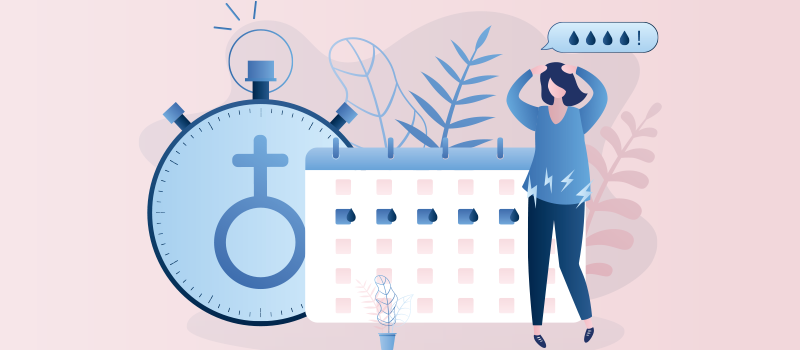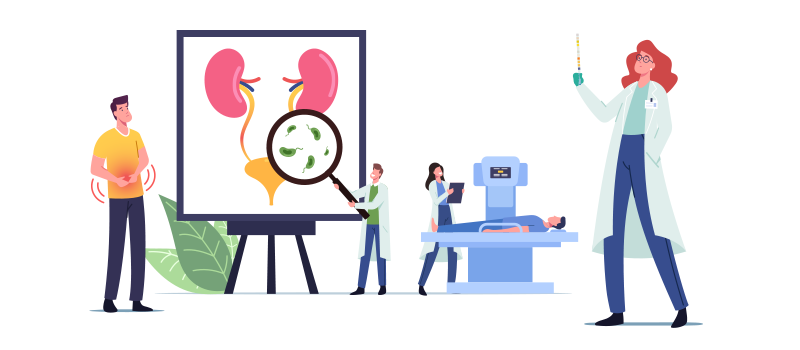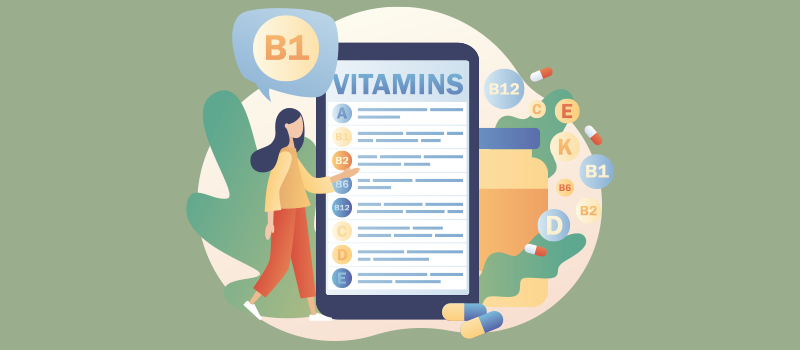What’s the Buzz
The Bee Healthy Blog
5 Effective Ways to Cure a UTI

Urinary tract infections (UTIs) are some of the most common infections leading to more than 8 million doctor visits each year. Around 60% of women and 12% of men will develop at least one UTI in their lifetime. UTIs happen when germs enter the urinary system. Bacteria and fungi can cause UTIs, with bacteria being the most common culprit; however, viruses can cause UTIs in some rare cases. Most UTIs are not serious and are easily treatable, but some can lead to serious problems like kidney infections or bacteremia (when the microbes enter the bloodstream).
According to the National Institute of Diabetes and Digestive and Kidney Diseases (NIDDK), antibiotics are the preferred method of treating UTIs, along with drinking plenty of fluid, preferably water, to flush bacteria from the urinary tract. There are antibiotics available to treat both uncomplicated and complicated urinary tract infections.
Some of the hallmark UTI symptoms include the increased urge to urinate, discomfort or burning sensation when urinating, red or cloudy urine, foul-smelling urine, and pelvic pain in women.
Not all antibiotics are effective in treating a UTI. Your doctor will select the most appropriate antibiotic based on the type of bacteria and your medical history, including drug allergies if any. After 2-3 days, the results of your urine culture will be available, then your doctor will decide the exact treatment length and if you should continue with your current antibiotic or start a new drug. This article will describe some of the most commonly prescribed antibiotics to cure a urinary tract infection.
What antibiotics are used to treat urinary tract infections?
UTIs are often classified as either “complicated” or “uncomplicated,” which determines how extensive the treatment should be. So what makes a UTI “complicated”? There are various contributing factors, including existing medical conditions, age, and structural or functional changes in the urinary tract. Complicated UTIs often don’t respond to traditional treatments; these types of UTIs will require antibiotics with broader coverage or even hospitalization for intravenous antibiotics.
First-line antibiotics for uncomplicated UTIs: nitrofurantoin (Macrobid), sulfamethoxazole/trimethoprim (Bactrim), and fosfomycin (Morunol).
Based on the UTI symptoms, medical history, and other concurrent medications, if any, below are some of the most common antibiotics your healthcare provider may prescribe to treat a urinary tract infection.
Nitrofurantoin
Brand names: Macrobid, Macrodantin
Macrobid is effective against E.Coli and Staphylococcus saprophyticus, two common UTI-causing bacteria. This antibiotic accumulates in the bladder, so it should only be used to treat an uncomplicated urinary tract infection or cystitis (bladder infection) and not pyelonephritis (kidney infection).
Macrobid is dosed twice daily and is more convenient than Macrodantin, which has to be taken four times daily. Nitrofurantoin is the active ingredient of Macrobid and Macrodantin. The difference between these two drugs is the forms of nitrofurantoin they contain. Possible side effects of nitrofurantoin include nausea, vomiting, headache, gas, and loss of appetite.
Trimethoprim-sulfamethoxazole
Brand names: Bactrim, Septra, Sulfatrim
Antibiotic treatment with Bactrim (sulfamethoxazole-trimethoprim) for UTI is one of the first-line options and commonly prescribed antibiotics. However, due to antibiotic resistance, Bactrim is not as effective against certain bad bacteria as it should be.
Common side effects of this UTI treatment include skin rash, nausea, vomiting, headache, dizziness, gas, and loss of appetite.
Fosfomycin trometamol
Brand name: Monurol
Fosfomycin is a very useful drug since it only requires a one-time dose to treat UTIs - an advantage compared to other UTI treatments requiring a 3 to 7-day course of antibiotics. More importantly, fosfomycin is used for treating UTIs caused by highly resistant bacteria. You may have heard of the term “antibiotic resistance,” which refers to how germs develop mutations and become very hard to treat with common antibiotics. This is why fosfomycin makes an excellent choice for people with multidrug-resistant UTIs where other antibiotics aren’t able to provide effective treatment.
Fosfomycin is generally very well tolerated with fairly mild side effects. Some of the common side effects include headache, throat discomfort, runny nose, nausea, vomiting, diarrhea, and vaginal inflammation.
Fluoroquinolones
Fluoroquinolones are a group of antibiotics that include ciprofloxacin and levofloxacin. These antibiotics are not typically recommended for uncomplicated UTIs or recurrent urinary tract infections because they can cause serious side effects such as tendon rupture and irregular heartbeats. Fluoroquinolones are reserved for complicated UTIs, including kidney infections and UTIs with prostate involvement in men.
Possible side effects of fluoroquinolones include changes in taste, nausea, vomiting, and diarrhea.
Beta Lactam Antibiotics
Brand names: Augmentin, Keflex, Omnicef
Augmentin (amoxicillin/potassium clavulanate) is a penicillin antibiotic, while Keflex (cephalexin) and Omnicef (cefdinir) belong to a drug class called “cephalosporins.” Penicillins and cephalosporins are closely related; both are classified as beta-lactam antibiotics due to their chemical structures.
Typically, due to antibiotic resistance, Augmentin is not the first choice for the treatment of UTIs, though it can still be used for some people. On the other hand, Keflex is one of the first-line treatments for UTIs. Compared to Keflex, Cefdinir has the capacity to deal with resistant bacteria and is a more effective agent overall. Therefore, Cefdinir should be reserved for complicated UTIs or in cases where the first-line agents cannot be used.
Common side effects of these antibiotics include stomach pain, nausea, vomiting, diarrhea, itching, rash, dizziness, and vaginal yeast infection.
What is the first choice antibiotic for UTI?
Nitrofurantoin, sulfamethoxazole-trimethoprim, and fosfomycin trometamol are the first choice antibiotics for simple urinary tract infections. Fluoroquinolones (ciprofloxacin, levofloxacin) and intravenous antibiotics such as ceftriaxone or an aminoglycoside, like gentamicin or tobramycin may be prescribed to treat complicated UTIs, kidney infections, and recurrent infections.
If you have recurrent UTIs, your doctor may put you on a regimen consisting of a low-dose antibiotic, a short course of antibiotics taken at the first sign of a UTI, or a dose after sexual intercourse.
What antibiotic is used for severe UTI?
Fluoroquinolones (ciprofloxacin, levofloxacin) may be used for severe urinary tract infections. These drugs are associated with more risks than some of the other antibiotics available to treat UTIs. Therefore, they are only used for a severe or complicated UTI or kidney infection when no other treatment options are available.
If you are allergic to fluoroquinolones, an aminoglycoside antibiotic is a good option for you.
Which antibiotic gets rid of a UTI fastest?
The choice of treatment for a urinary tract infection also depends on how often you get UTIs (whether you have recurrent UTIs) and other factors like your medical history and medication allergies.
For example, sulfamethoxazole/trimethoprim is the first-choice drug for UTIs. It can treat an uncomplicated UTI in as little as 3 days. However, if you have a sulfa drug allergy, you cannot take this course of antibiotics.
Nitrofurantoin is another first-choice UTI treatment. However, it takes slightly longer (5-7 days) to treat a UTI.
Another antibiotic that can get rid of a UTI fast is ciprofloxacin (Cipro), which can work in as little as 3 days. However, this antibiotic carries some serious risks like tendon rupture, and is only used if other treatment options have not worked.
Extended-spectrum beta-lactamase (ESBL) is an enzyme made by certain bacteria that can make many antibiotics ineffective. If you have a UTI caused by ESBL-producing bacteria, you may need hospitalization and intravenous (IV) antibiotics to treat your infection. Other risk factors like a weakened immune system may also dictate the choice of antibiotics in some people.
How fast should a UTI clear up with antibiotics?
If you have been diagnosed with a urinary tract infection and have been prescribed an antibiotic, you should start to feel better within 3-5 days. To prevent antimicrobial resistance, you should finish the entire course of antibiotics prescribed by your healthcare provider even if your symptoms are better. Proper treatment is important to kill all the bacteria and prevent antimicrobial resistance.
How can I prevent UTIs?
If you get frequent UTIs, the American Urological Association suggests doing several things to prevent future UTIs. You should drink plenty of water to flush out your urinary system, urinate as soon as you feel the urge (not hold it in), keep your genital area clean, and empty your bladder after sexual intercourse. In addition, post-menopausal women can talk to their healthcare provider about using vaginal estrogen to lower their UTI risk.
It’s important to get a proper diagnosis and treatment for a UTI by taking antibiotics if needed. Home remedies and natural supplements like vitamin C and cranberry juice are not proven to cure urinary tract infections. Remember, leaving a UTI untreated can be uncomfortable but also dangerous. If left untreated, UTIs can lead to kidney stones and other serious kidney problems.
References:
- https://www.urologyhealth.org/healthy-living/urologyhealth-extra/magazine-archives/summer-2016/understanding-utis-across-the-lifespan#
- https://www.niddk.nih.gov/health-information/urologic-diseases/bladder-infection-uti-in-adults
- https://www.urologyhealth.org/urology-a-z/u/urinary-tract-infections-in-adults
- https://www.mayoclinic.org/diseases-conditions/urinary-tract-infection/diagnosis-treatment/drc-20353453












SOCIAL